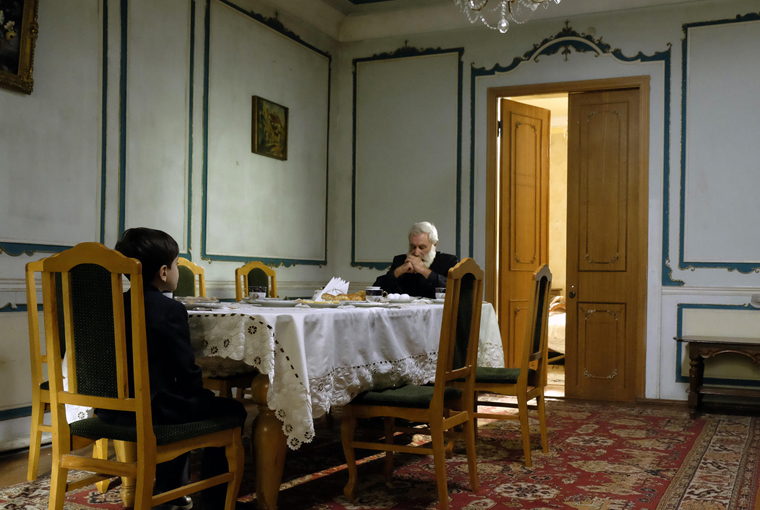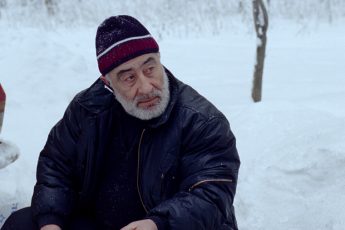About Film or How We Should Be Scared of Current Events
Nariné Mkrtchyan and Arsen Azatyan’s About Him or How He Did Not Fear the Bear (Nra masin kam te inchpes na chvakhetsav arjits, 2019)
Vol. 91 (January 2019) by Anastasia Eleftheriou
Nariné Mkrtchyan and Arsen Azatyan’s new feature About Him or How He Did Not Fear the Bear premiered in this year’s IFFR Deep Focus program. Basing their project on the 2015 Gyumri massacre in Armenia that claimed the life of seven members of a local family, Nariné Mkrtchyan and Arsen Azatyan opted to make a feature film – with a few documentary elements – which, according to them, wished to address issues of “dignity” and “violence”.
The film begins by depicting the murder of a whole family at the hands of Russian soldier Valery (Ivan) Permyakov, a serviceman stationed at the Military Base in Gyumri. We see the soldier entering the house and killing the family members one by one, following mostly his perspective. Then we are introduced to two local veterans, Vahan and Sargis, who decide to take the law into their own hands, avenge the family, and restore dignity and justice for their people. After the massacre, protests break out all around the city. We see real images of these protests – supposedly through the main characters’ laptop screens. We also see Vahan’s wife, a quiet and religious woman who is worried about her husband’s lust for blood. She visits the local and seemingly influential priest, Father Avetis, asking him to try to talk to her husband and change his mind. Father Avetis holds an important position in the community, defending ideas of peace and tolerance, and inciting people to stop protesting and let God be the judge of the situation. As with the TV-images of the protests, the father’s authority comes to us mostly through mediatized images (this time on a cell phone). These allusions to different forms of mediatized storytelling are successfully woven into the narrative and draw our attention to questions regarding the power and manipulation of images. Local people rely a lot on their screens and mobile phones for information and political opinions. Luckily, the police are quicker than Vahan and Sargis in finding the Russian soldier and arrest him. In the cell, the Russians ask Father Avetis to visit Ivan and try to make sense of what motivated him to commit the murder. The visit is more than a police interrogation, though. The father’s encounter with Ivan could potentially be mediatized as a step towards forgiveness, calming the masses’ hunger for revenge.
As these stories unfold, another level of meta-performative image-making unfolds: a children’s play interrupts the narrative. In the children’s tale (a Russian folk tale reminiscent of Peter and the Wolf), a young boy called Ivan struggles with a bear – something like the monster within himself. These theatrical episodes are accompanied by separate musical pieces and a group of young girls surrounding Ivan at each step of his story. This poetic depiction of the psychology of a murderer works well, as we are invited to see Ivan as an innocent human being, his childhood giving no clues of what might have gone wrong with his soul.
For all its meta-narrative complexity, About Him or How he Did Not Fear the Bear falls short in deepening its own cinematographic approach and storytelling. Almost all scenes are shot in master shots that are interrupted by random close-ups. There are also recurrent reverse shots that seem to resemble TV B-rolls rather than changes of perspective. This TV style (another trademark being the soap-opera-like acting) may have been intended, recalling the uncanny feeling that the media has turned all aspects of life into an imitation of life. Nevertheless, as is often the case, without any truth, reality or honesty to hold on to, this approach either provokes cynicism or flat-out boredom. While the children’s folk tale is beautifully shot (albeit also mostly in master shots), with a folk décor, beautiful colors and an atmosphere that tries to draw from Parajanov’s tableau-vivants, the children’s acting in this part outshines that of the adults in the rest of the film. If people’s dialogs are really as dull as in soap-operas, it may not be enough to simply reproduce them. Directors from Douglas Sirk to Xavier Dolan have found poetry in the way our dialogs echo the stuff we hear on TV.
A word about gendered images may be of use here. The depiction of women in the film is quite revolting (and saying that this is Armenia does not work as an excuse in a film making a show of self-awareness). Women are either their men’s servants (the father’s wife); crying and shouted at (Vahan’s wife); or just sexual decorations (a divine-looking, blonde nude could not care less about the protests, but is worried about not being able to see her lover for a long time).
If there is something like a core in About Film or How we Should Be Scared of Current Events, then it tries to depict issues of dignity. But how can such a value exist, let alone be portrayed, when no political background or context is given? Maybe raw violence has no nationality, but the mass protests were related to the general feelings people in Armenia had regarding the presence of Russian military bases. Conspiracy theories and complex political issues were at stake, even in media representations. The orthodox church remains diplomatic in the film (as it is in reality due to its closeness to Russia), but concepts like “human dignity” and “justice” are too complex to be thrown out there without a meaningful conversation, be it in cinematographic language or in words.
As could be argued for other films that deal with traumatic current events (think about Loznitsa’s recent Maidan or Donbass), it may be useful to reconsider aspects of timing with regards to the cinematographic representation of such events. Obviously, journalists should report on such affairs and committed filmmakers should grab a camera and go “in the field” to document reality taking considerable risks. Feature films, however, have the privilege to let time pass, and fiction stories can reflect on events post factum, with perspective. By producing creative environments, they can let free cinematographic forms communicate statements on what these events have left behind: for the people they affected, for the world, and for cinema. Let’s let history fall into place and take a deep breath.




Leave a Comment